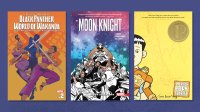Discovering the Depth in Graphic Novels
Graphic novels can give middle school readers rich opportunities to explore literary themes and conventions.
Your content has been saved!
Go to My Saved Content.In spite of their reputation for simplicity, graphic novels can display a surprising level of depth. This sense of depth can come through in a variety of ways—from the language to the interplay of words and images to the themes that can be explored in visual texts. And like novels, graphic novels employ a range of literary conventions, so they’re ripe for classroom discussion.
Teachers may feel graphic novels are too simple because the pictures do some of the work that words have to do in novels, but those pictures have their own particular grammar and conventions, a point Scott McCloud makes in his graphic novel about graphic novels, Understanding Comics: The Invisible Art. Those conventions provide plenty of scope for learning and analysis.
As a young reader, I was enthralled with comic books and graphic novels, and they were the center of my most engaged reading life. It’s no wonder that I took this passion into the middle school classroom as a teacher—and graphic novels were among the most frequently checked out books in my classroom library.
As a doctoral student in literacy, I’ve had more time to reflect on comics and graphic novels. I’ve also had the opportunity to read more widely and explore them in coursework.
Images and words work together to create a variety of meanings in graphic novels, with the space between panels representing sometimes seconds and sometimes eons. Graphic novels can work as historical tales, autobiographies, or coming-of-age stories. There’s much than heroes and spandex to be found in comic books—a point we can easily see by looking at three examples.
American Born Chinese
American Born Chinese by Gene Luen Yang—named National Ambassador for Young People’s Literature by the Library of Congress for 2016–17—fascinates me. When I talk with students about reading choices, this book is one I always turn to first.
What makes American Born Chinese unique is not only its exploration of Asian American culture but the intertextuality of its narrative. The first section of the book takes us back to ancient, mythic times. We are then presented with a story set in the present that focuses on teen angst and the acculturation in the U.S. of a child of Chinese immigrants. The story then switches to a sitcom-like world of racial stereotypes. Most notable in this third level is the presence of canned laughter along the bottom of panels, as well as colorful titles, which reinforce the sitcom motifs.
These three sections are intertwined and ultimately resolved. The result of this synchronized, thoughtful design is surprising and delightful. Moving beyond a simple three-part narrative, the story explores identity and culture, and plays with the reader’s expectations by taking the narrative in challenging directions.
Black Panther: World of Wakanda
The recent movie Black Panther was a big hit, but what is unique in Black Panther: World of Wakanda, written by Ta-Nehisi Coates and Roxane Gay, is the focus on characters who would often be considered background elements to the major story.
T’Challa, the Black Panther, actually plays a relatively minor role in the story, appearing only now and then in this collected volume. The title of the book is a clue that the focus here is wider, taking in the nation of Wakanda—the fictional country that T’Challa rules—as a whole, with a particular emphasis on two members of the royal guard, Ayo and Aneka.
What stands out about this creative choice is that it can open a discussion among young readers around gender representations as these female warriors become the major narrative concern. In this way, Coates and Gay lead us to learn more about characters who would in other stories be relegated to the dimension of flat characterization—they would be a backdrop to the story of T’Challa. This depiction of the wider world in which a superhero lives reaches a level of depth not often found in the standard superhero storyline.
Moon Knight
Jeff Lemire’s treatment of the Marvel character Moon Knight can be found in three collected volumes: Lunatic, Reincarnations, and Birth and Death.
Lemire tells the story of a character who exists as a mythic being, a traditional vigilante, and a madman. These identities lead the character to entirely different realities as the narrative starts, stops, and moves to different locations.
Lemire takes the three identities and stacks them on each other, allowing them to interact. The books play with many graphic novel conventions and can be used to discuss ways of knowing. The main character doubts himself and his existence, and we find ourselves believing and then doubting him at different points in the story, calling to mind the literary device of the unreliable narrator.
We are left with questions at the end of the narrative, and the boundaries between what is real and what is not are called into question. While sometimes intense and edgy, this three-volume narrative displays a psychological depth that is unique and compelling.
These three stories represent the kind of depth that can be explored in graphic novels. Often, texts that have a reputation for simplicity can be so much more—they may have the potential to surprise readers in new ways. Each of these titles is concerned with identity, and each has the potential to encourage meaningful and unique dialogue with students.
